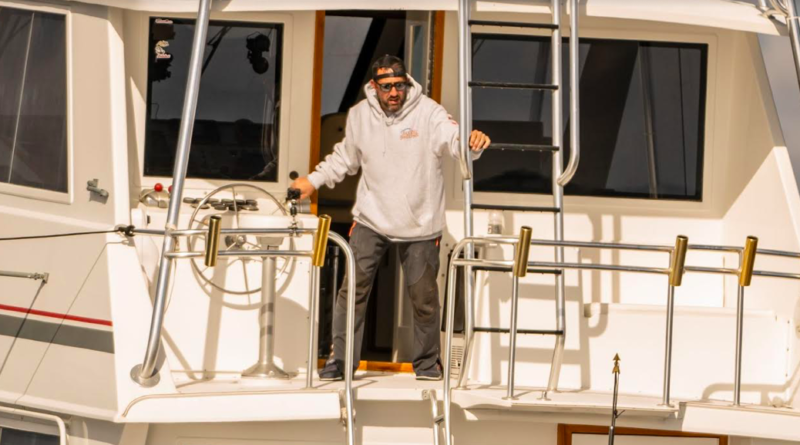INTERVIEW: Captain Bobby Earl on the secrets of fishing off OBX
Photo: Bobby Earl is one of the captains featured on Wicked Tuna: Outer Banks Showdown. Photo courtesy of Nat Geo / Provided by High 10 Media with permission.
A new season of Wicked Tuna: Outer Banks Showdown premieres tonight, July 17 at 9 p.m. on Nat Geo. The reality series documents the travails of anglers coming down from the waters of Massachusetts during the wintertime to chase mega bluefin tuna in the choppy waters off the Outer Banks of North Carolina. One of the favorites on the series is Captain Bobby Earl, who heads the Reel E’ Bugging boat.
This year, when the premiere airs on TV, Earl and his family will be having a low-key affair.
“It’s kind of funny the last three years we threw a party, and we decided not to this year because when you throw a party you don’t get to watch it,” Earl said in a recent phone interview. “People are too loud. Everyone’s drinking and eating and making noise, and you can’t hear the TV. So the last couple years we actually rented out a place and threw a big bash, but this year we decided not to.”
The fishing captain, who is a native of Queens, New York, actually counted himself as a fan of the Wicked Tuna shows before he joined the franchise. He watched the reality series for six or seven years, and then his dream came true when he was invited on the show. He believes that’s why he fishes so hard on television — he’s simply more excited than anyone to be out there with the camera crew.
Earl, who previously worked for a Wall Street company (cue inside jokes about sharks in the water), has been heading south to OBX for 12 years, eight of them before the cameras started rolling. He knows the trip well, coming in through Kitty Hawk, Kill Devil Hills and Nags Head. These shoreside towns and barrier islands are something special for anglers.
“It’s an aquarium out there,” he said. “So we always fish for tuna and giant tuna and all your pelagic species on what we call the ‘100-Fathom Line.’ There’s a place where there’s a canyon that runs the length from the Bahamas all the way up to Maine. It’s where the water goes from about 200-foot deep to anywhere from 10,000 to 12,000-foot deep. There’s an actual underground canyon that runs the whole length of the U.S. … That’s where the big fish are, so it’s funny, Hatteras to Oregon Inlet is the shortest distance to that canyon. It’s about 37 miles, so if you fish out of South Carolina, you have to go 60 [miles]. If you’re on Long Island, you have to go 100 [miles]. So where that canyon is closest to the United States is North Carolina, and I believe that’s why the fishing is exceptional.”
Earl, letting viewers know some of his secrets (and scientific knowledge), said that the tuna migrate in these Gulf Stream waters, running south to north. The current travels 4 or 5 mph north, causing his boat and others to hook a hard left once they hit the warmer waters in the ocean.
“They follow it as it works its way north,” the captain said. “That’s why there will be tuna in the south, and then right about now they’re starting to catch them up in Massachusetts because they work their way up. There’s a lot of theories, but we know this, we know where the shallow water falls off to the canyon, it also has a huge temperature break. That’s the Gulf Stream at that canyon. That water is usually 76-78 degrees no matter what time of year it is, so when we leave the docks in the Outer Banks, it’s about 40 degrees. … By the time you get to the Gulf Stream, the water jumps. I mean you could see smoke on the water. It’s that’s visible, but it jumps from 40. Halfway there it’s 55, and then 60, and then all of a sudden it’s 74 degrees. And right on that edge is where you’ll find all the bait, the porpoises, the whales, the sharks. It all happens where that hot nutrient water is running up along the cold water.”
Getting to the Gulf Stream is a difficult task. Earl called the trip along those 37 miles godawful, like running a gauntlet. In the wintertime, when the tuna are biting off OBX, there are storms and cold weather. There’s also an 8-mile stretch between the harbor and a bridge that opens up to the ocean, and within these waters the depth can jump back and forth between 2 feet and 10 feet.
“It’s like an obstacle course just getting to the bridge,” Earl said. “We usually do that in the dark of night as well, which doesn’t help, and then you get to the bridge, and you have to get under the bridge. With cross-currents and wind, it’s not that simple. Then, for all your trials and tribulations you get to deal with the sandbar, and the sandbar at Oregon Inlet will just gobble up boats. I believe this year there were two boats washed up on the beach. I mean every year there’s a shrimp boat washed up on the beach. That inlet just gobbles up boats. It’s literally a gauntlet, and then once you get through all of that, it’s a nice three-hour ride out to the canyon.”
Now viewers can watch Earl and other Wicked Tuna captains brave these waters looking for those elusive tuna.
By John Soltes / Publisher / John@HollywoodSoapbox.com
Wicked Tuna: Outer Banks Showdown premieres Sunday, July 17 at 9 p.m. on Nat Geo. Click here for more information.

